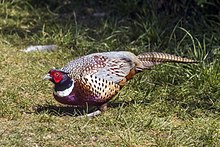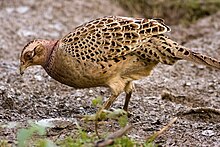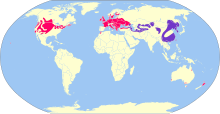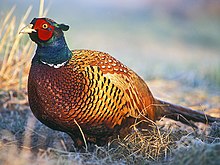| Common pheasant Temporal range:
| |
|---|---|

| |
| Male ("cock") | |

| |
| Female ("hen") both in England | |
| Scientific classification | |
| Domain: | Eukaryota |
| Kingdom: | Animalia |
| Phylum: | Chordata |
| Class: | Aves |
| Order: | Galliformes |
| Family: | Phasianidae |
| Genus: | Phasianus |
| Species: | P. colchicus
|
| Binomial name | |
| Phasianus colchicus | |

| |
| Geographical distribution of common pheasant Native Introduced | |
| Synonyms | |
|
Phasianus phasis | |

Note thin white neck-band due to a ring-necked subspecies' contribution to hybrid gene pool
The common pheasant (Phasianus colchicus), ring-necked pheasant, or blue-headed pheasant, a bird in the pheasant family (Phasianidae). The genus name comes from Latin phasianus, "pheasant". The species name colchicus is Latin for "of Colchis" (modern day Georgia), a country on the Black Sea where pheasants became known to Europeans.[2] Although Phasianus was previously thought to be closely related to the genus Gallus, the genus of junglefowl and domesticated chickens, recent studies show that they are in different subfamilies, having diverged over 20 million years ago.[3][4]
It is native to Asia and parts of Europe like the northern foothills of the Caucasus and the Balkans. It has been widely introduced elsewhere as a game bird. In parts of its range, namely in places where none of its relatives occur such as in Europe, where it is naturalised, it is simply known as the "pheasant". Ring-necked pheasant is both the name used for the species as a whole in North America and also the collective name for a number of subspecies and their intergrades that have white neck rings.
It is a well-known gamebird, among those of more than regional importance perhaps the most widespread and ancient one in the whole world. The common pheasant is one of the world's most hunted birds;[5] it has been introduced for that purpose to many regions, and is also common on game farms where it is commercially bred. Ring-necked pheasants in particular are commonly bred and were introduced to many parts of the world; the game farm stock, though no distinct breeds have been developed yet, can be considered semi-domesticated. The ring-necked pheasant is the state bird of South Dakota, one of only two US state birds that is not a species native to the United States.
The green pheasant (P. versicolor) of Japan is sometimes considered a subspecies of the common pheasant. Though the species produce fertile hybrids wherever they coexist, this is simply a typical feature among fowl (Galloanseres), in which postzygotic isolating mechanisms are slight compared to most other birds. The species apparently have somewhat different ecological requirements and at least in its typical habitat, the green pheasant outcompetes the common pheasant. The introduction of the latter to Japan has therefore largely failed.
- ^ BirdLife International (2016). "Phasianus colchicus". IUCN Red List of Threatened Species. 2016: e.T45100023A85926819. doi:10.2305/IUCN.UK.2016-3.RLTS.T45100023A85926819.en. Retrieved 12 November 2021.
- ^ Jobling, James A (2010). The Helm Dictionary of Scientific Bird Names. London: Christopher Helm. pp. 113, 302. ISBN 978-1-4081-2501-4.
- ^ Kimball, Rebecca T.; Hosner, Peter A.; Braun, Edward L. (1 May 2021). "A phylogenomic supermatrix of Galliformes (Landfowl) reveals biased branch lengths". Molecular Phylogenetics and Evolution. 158: 107091. doi:10.1016/j.ympev.2021.107091. ISSN 1055-7903. PMID 33545275. S2CID 231963063.
- ^ Lawal, RA.; et al. (2020). "The wild species genome ancestry of domestic chickens". BMC Biology. 18 (13): 13. doi:10.1186/s12915-020-0738-1. PMC 7014787. PMID 32050971.
- ^ Cite error: The named reference
Robertson1997was invoked but never defined (see the help page).
